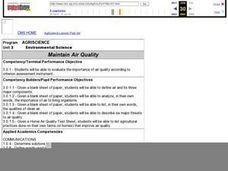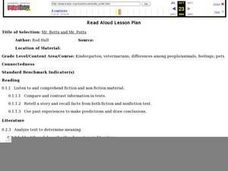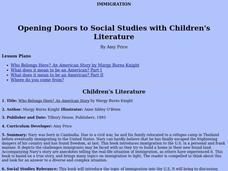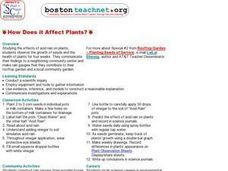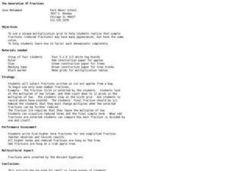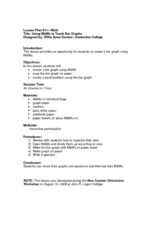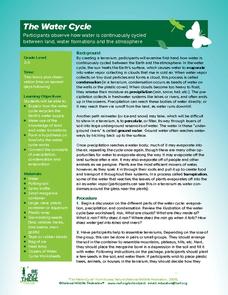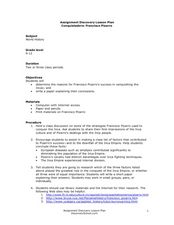Curated OER
Cloudy With A Chance of Meatballs
Third graders read the book, Cloudy with a Chance of Meatballs." Using the internet, 3rd graders research weather conditions, plants, animals and foods from different countries. After sharing information, they discuss similarities and...
Curated OER
Maintain Air Quality
Students are engaged in discussing air quality through hands-on demonstrations using balloons, sealed jars, and toy cars. Students conduct a home radon test to measure their air quality.
Curated OER
Inventors Timelines
Students create a class timeline using the patent year for their selected inventor or invention. Using a piece of yarn, they physically create a timeline, and create and answer math word problems using the years from the timeline.
Curated OER
"Mr. Betts and Mr. Potts"
First graders listen to the book "Mr. Betts and Mr. Potts" and examine the career of being a veterinarian. They categorize animals based on whether they could be house pets or not, develop a class pet graph, and list the various...
Curated OER
Searching for Me in You
Students explore their own culture and identity through the study of literature and artwork of other cultures. Students read and discuss Last of the Breed and identify cultural values. They create a presentation that incorporates their...
Curated OER
Opening Doors to Social Studies with Children's Literature
Fifth graders read a story about immigration, listen to songs about America and explore the history of their ancestors. They discuss how immigration creates a multicultural country. Pupils create a collage of the people in America. ...
Curated OER
Carbons to Computers - 2
Learners organize information obtained by observation and order it in historical sequence; to use evidence to support hypotheses.
Curated OER
How Does it Affect Plants?
Students examine the effects of acid rain on plants. They observe the growth of seeds and the health of different plants for a month. They share their findings with the community.
Curated OER
The Generation of Fractions
Students explore the process of reducing fractions to simplest form by using a multiples grid. In this simplest form lesson plan, students pull different fractions out of a bag and then consult their grid to discover all the multiples...
Curated OER
Design Your Perfect Career
Students incorporate the design process to create their own perfect job or career. In this career design lesson, students develop questions to research for a future career choice. Students brainstorm about their personal skills to use in...
Curated OER
Using M&M's to Teach Bar Graphs
Motivate your class with this lesson. While not fully fleshed out, this activity is meant to be used as an introduction to the use of bar graphs. Learners sort M&M's and create bar graphs to display their information.
Curated OER
Check Out Lights and Shields with Beads
Students explore Ultraviolet detecting beads and conduct several investigations with them. For this investigative lesson students participate in an experiment to see the harmful effects of UV light and discuss their findings.
Curated OER
Wacky Water Critters
Students visit a local creek or stream. They collect water samples from the creek and observe and sort the "water critters" they find in the sample, observing smaller organisms under a microscope if necessary. They identify each organism...
Curated OER
Technology-commected Folklife Lesson Plan: Fables
Students discuss ways the stories were alike and different. The teacher demonstrate how to draw a Venn diagram using Microsoft Word. They label the two circles and enter the likenesses and differences on the diagram.
Curated OER
"Julie of the Wolves"
Fifth graders research life in Alaska and compare life there to their lives in this lesson. They read "Julie of the Wolves." They research through the novel and other reference books facts about the Alaskan climate and geography. They...
Curated OER
Enrichment Activities - "Mrs. Frisby and the Rats of NIMH"
Fifth graders read the novel "Mrs. Frisby and the Rats of NIMH." They discuss the various characters in the book, and the different types of conflict that take place within the book. They also research owls and rats to make comparisons...
Curated OER
The Water Cycle
Students are introduced to the components and importance of the water cycle. They are shown how groundwater moves using a model. Students list 9 places on earth where water is found. They define the terms cycle and water cycle.
Curated OER
Microscopes: Is what you see, what you got?
Eighth graders identify the parts and functions of the microscope. In this biology instructional activity, 8th graders observe different samples under different types of microscopes. They compare and contrast the details they see.
Curated OER
Identify Plant Nutrient Requirements
Students are given standard elemental nutrients, identify plant nutrient requirements based on criteria outlined in assessment instructment. They, are given standard elemental nutrients, provide all means and chemical symbols of plant...
Curated OER
Poetry
Fifth graders preview different poetry selections form different poets to narrow their criteria for a favorite poem. They use the web and written sources to find a favorite poem and then give an oral interpretation of their poem in class...
Curated OER
Living and Non-Living
Students discover the basic needs of life. In this science lesson plan, students explore how all living things need air, water, food and shelter
Curated OER
Conquistadors: Francisco Pizarro
Students examine the work of Spanish conquistadors. In this Inca lesson plan, students research factors that led to Pizzaro's conquest of the Inca and compose essays pertaining to their findings.
Curated OER
Changes in Latitudes, Changes in Attitudes
Sixth graders discuss how people, society, and technology change over time through a unit of integrated lessons. In these changes in society lessons, 6th graders discuss the answers to many questions about how changes effect the...
Curated OER
Sixth Grade Word Problems
For this word problem worksheet, 6th graders problems using given information and mathematical equations. Students solve for 19 problems showing work as needed.



